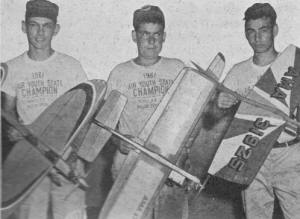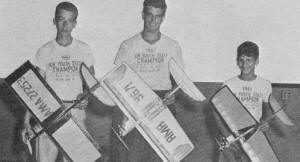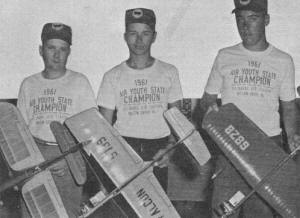|
The Academy of Model Aeronautics
(AMA) 1961 Nationals competition was held at the
Willow Grove Naval Air Station in Pennsylvania (Air Youth State Competition,
aka AYSC). Up until the early 1970s, the U.S. Navy sponsored the AMA Nationals in
an effort to attract America's youths into naval aviation as aircraft technicians
and as pilots. It ended as youth participation in competition ebbed and defense
budgets got trimmed. This story from the March 1962 American Modeler reports on
young men from 42 states for a new-type Grand National Youth Championship. Do you
see anyone you know in the group photo? If so, please send me an e-mail and I'll
add his name to the page.
America's Best Youthful Flyers
Forty-two fortunate and skilled State champions from all parts of our land competed
at the 1961 Willow Grove NATS to decide a new-type Grand National Youth Champion.
In addition to this championship, trophies were also awarded for the four U-control
categories, stunt, speed, endurance and beauty, which comprised the Quadrathon model
competition.

The reigning Air Youth all-round Grand Champ is
Edward Elasick, age 15, from Garfield, N. J. The special category awards went to
Richard Lengel, 14, Bridgeport, Conn. for SPEED; John C. Davis, 14, Indianapolis,
Ind. for ENDURANCE; Gary Cipra, 13, Cleveland, Ohio for BEAUTY and to Elasick for
STUNT.
Well, how did it all go? - Answer: Fine! ... with only a very few reservations.
Each Air Youth State representative was provided with an all-expense deal which
included round trip air transportation, meals and lodging, personal expense money,
plus special clothing. The fly-off was actually a contest "within" the big annual
Nationals in that completely separate facilities were provided for the AYSC (Air
Youth State Championship) competitors. They had their own barracks, work room, meeting
room and a close-by control line flying site. The Navy provided bus transportation
from barracks to chow hall at the far side of the airfield.
Under the able direction of "Rich" Palmer and Matty Sullivan, assisted by HIAA's
Virginia M. Lofft and numerous Navy personnel, the actual contest flying went off
quite smoothly. There were some complaints over the first-time rule changes and
scoring operations. General level of workmanship on the models was high, as was
the quality of flying done by the majority of the competitors. Real contest know-how
was displayed by most - engines were started quickly, there were no in-flight breakdowns,
only a few wheels came off along the way. Out of 42 models entered 35 were intact
at the end of competition. Those that did become casualties suffered minor damage
mostly, only a very few were total wash-outs.

AYSC Endurance winners (from far lt.): John Davis, Ind., 1st;
David Wagner, N. M., 2nd; James Perwein, Minn., 3rd.

Best Stunters (from lt.):
Eddie
Elasick, N. J., 1st; Gary Yonamine, Hawaii, 2nd; Jim Stover, Pennsylvania, 3rd.

AYSC Speed champs (above, from lt.): Richard Lengel, Conn., 1st;
Gene Stolz, La., 2nd; Steven Levinstein, N. Y., 3rd.

Beauty winners (at right), from lt.: Gary Cipra, Ohio, 1st; Elasick,
N. J., 2nd; Gary Zeller, Mo., 3rd.
Kit models predominated with Goldberg's "Shoestring" and Top-lite's "Flight Sreak"
leading. There were more Fox engines observed than any other type, K&B's were
second, with a fair sprinkling of Hi Johnson's, McCoy's, Max OS's, Super Tigre's,
plus several foreign diesels. Most fliers used .29's and 35's with a few .19's and
.15's.
Champion Elasick flew an original design by John D'Ottavio. Originally dubbed
"Jr. Falcon" it was officially named "Topper." More on the model later. Other notable
original designs included a slim, elliptical-surface "Hummingbird," designed by
Charles Mackay, flown by Indiana champ John C. Davis. An outstanding original was
the twin-boom, Johnson 29 powered job flown by Kenny Brunck from Lexington, Ky.
Missouri's entrant, Gary Zeller, had a clean wide-track gear profile design inspired
by the Macchi seaplane racers of the mid-'30s.
While the ideal all-event model may not as yet have emerged, many of those competing
came close. The economical diesels were surpassed in endurance by the Davis entry
having a Fox .19 and a special self-leveling fuel tank, his time aloft was 20 min.,
40 sec. The smaller .15 engine powered planes were hard put to come even with the
.29 and .35's in stunt and speed. Most purposely sacrificed performance in one event
to perform well in the other categories.
A survey of contestant opinion showed that the majority were well pleased with
the AYSC program and its model requirements. Among the dissenters there were some
suggestions for improvements. These included: limit to one engine and flying line
size. Allow larger airplanes for better stunt flying. Have better, earlier distribution
of finalized rules prior to state contests. Arrange schedule at NATS so that AYSC
contestants can compete in other events more easily. Stricter adherence to rules
in the national fly-off. Matty Sullivan suggested that in the future models be built
from kits right at the NATS then flown in the contest to preclude the old bugaboo
of all contest flying: the entering of models not built by the flyer.
Highlights:
Needle valves removed after each flight to prevent pre-setting. One stunt maneuver,
a horizontal square eight, was added to make competition tougher at NATS. Boys called
each other by state names rather than bothering with given names. The contestants
were most willing to help and crew each other ... real cooperation was most evident.
Alaska should have gotten a prize for his ability to sleep anywhere, anytime. Hawaii's
Gary Yonamine displayed the most sportsmanlike attitude by strict compliance with
every part of the rules. Casualty, Vermont's Chris Buttolph came down with a mild
case of the mumps. A firm Navy hand took some of the starch out of some midnight
cain-raisers. A bouquet to "Den mother" William L. MacMillan Jr., HIAA director,
who headed up the operation and smoothed the problems of the encampment. Bouquets
also to the Navy hosts, timers and judges for a job well done. The heat K.O.'d two
Navy officer judges while on scoring duty at the flying circles. Bouquets to the
weatherman for fair skies and little wind; brickbats to the same guy for high heat
and humidity.
What happened to "no-show" Arkansas, Colorado, Montana, Nebraska, North Dakota,
Mississippi, Georgia and Oregon? Although many statewide contests did not gain the
widespread support desired, the final's fly-off was tops. The HIAA (Hobby Industry
Association of America, Inc.) has indicated continued support and it is hoped the
'62 events will be bigger and better. The Air Youth program is not only the best
event for the younger modeler but it is the first of nationwide scope.
And now, to the first "4-way" true AYSC winner, Edward Elasick and his model.
Eddie is a real model builder's modeler. He smiles a lot, and seems quiet, but when
he's out in mid-circle he makes his model talk for him. Eddie developed his building
and flying skill fast. Before becoming AYSC champion he had been in modeling only
2 1/2 years.
As a result of his initial success in model competition, and his contact with
AYSC prime-mover "Rich" Palmer at Hobbytowne, Eddie Elasick decided to tackle AYSC
competition in 1961. Here again the excellent advice of adult expert modelers proved
to be of tremendous help to Eddie. His friendship with such unselfish people as
Art Cangialosi and John D'Ottavio was just the boost needed. Eddie built and flew
a model designed by Mr. Cangialosi to win the New Jersey state AYSC finals. The
Grand National Championship winning model used by Eddie was specially designed by
Mr. D'Ottavio.
As the date for the N. J. state AYSC fly-off approached last year there was a
rush for kits and suitable plans by many boys in the northern N. J. area. The local
fields were buzzing with Shoestrings, Ringmasters, Flite-Streaks and originals.
Fourteen contenders fought it out in the N.J. state finals. Stunt was somewhat of
of a heart-breaker - many of the young fliers scored low in this phase. Most were
gunning for maximum points in speed and endurance, but it was stunt that made the
difference! As a result of practicing ALL the events, Eddie Elasick placed high
in ALL phases, gaining top score, thus winning the N. J. AYSC championship and the
right to represent the Garden State in the National meet.
As noted, Eddie flew a model designed by Art Cangialosi in the state fly-off.
This neat twin-tailed job had a built-up fuselage, a fairly thin wing and was powered
by an inverted Fox .25 engine.
After the state finals Eddie and designer O'Ottavio put their heads together
to work out a simpler model hoping for improved stunt performance in the Nationals.
The result? "Topper."
Flying "Topper" at the 1961 AYSC Nationals, Eddie Elasick placed first in stunt
scoring, second in beauty and sixth in both speed and endurance. These together
added up to the grand championship. As a capper Eddie went on to win a fifth place
in Junior Precision Acrobatics in the 1961 National competition. (He did this on
only two hours sleep after traveling from Willow Grove N.A.S. to New York City to
appear on the "Today" TV show.)
Concerning that 1961 A YSC competition we asked Eddie Elasick how he felt about
the whole affair. With a wide grin he replied: "It was a good deal." A truly happy
understatement.
We also had a discussion about A YSC with those all-important men behind Eddie
Elasick, his father Edward Sr. and designer John D'Ottavio.
Both felt that some contestants at the "Nats" were not too well qualified. Some
had only competed against a few other flyers in state contests. They were lost without
their familiar helpers, or expert assistance on engine handling.
More advance publicity should be given to AYSC programs and particularly to rule
distribution well in advance of events. AYSC is only a few years old and has a few
growing pains to get over.
Limit of 38" span should be increased a few inches to permit larger wings for
better stunting, and to allow more kit models.
Contestants should concentrate on stunt and original design to gain high scores.
Endurance and speed with stock engines and fuel limit is wide open since everyone
has the same problems of heat and humidity on contest day.
AYSC competition at Nationals should come first, but scheduled so contestants
can compete in regular National events, as long as this would not interfere with
Air Youth events. A trip to the "Nats" is a big thing for these Junior flyers and
they like to see as much as possible.
Here's one to chew on: Workmanship and beauty scoring should be dropped. It is
discouraging to young builders to be beaten by appearance points. Judging should
be on the flying performance only.
Both adult members of the winning Elasick team had the highest praise for the
whole AYSC program. The criticism expressed they considered of minor importance.
Two more avid AYSC boosters would be hard to find.
Posted August 4, 2013
|